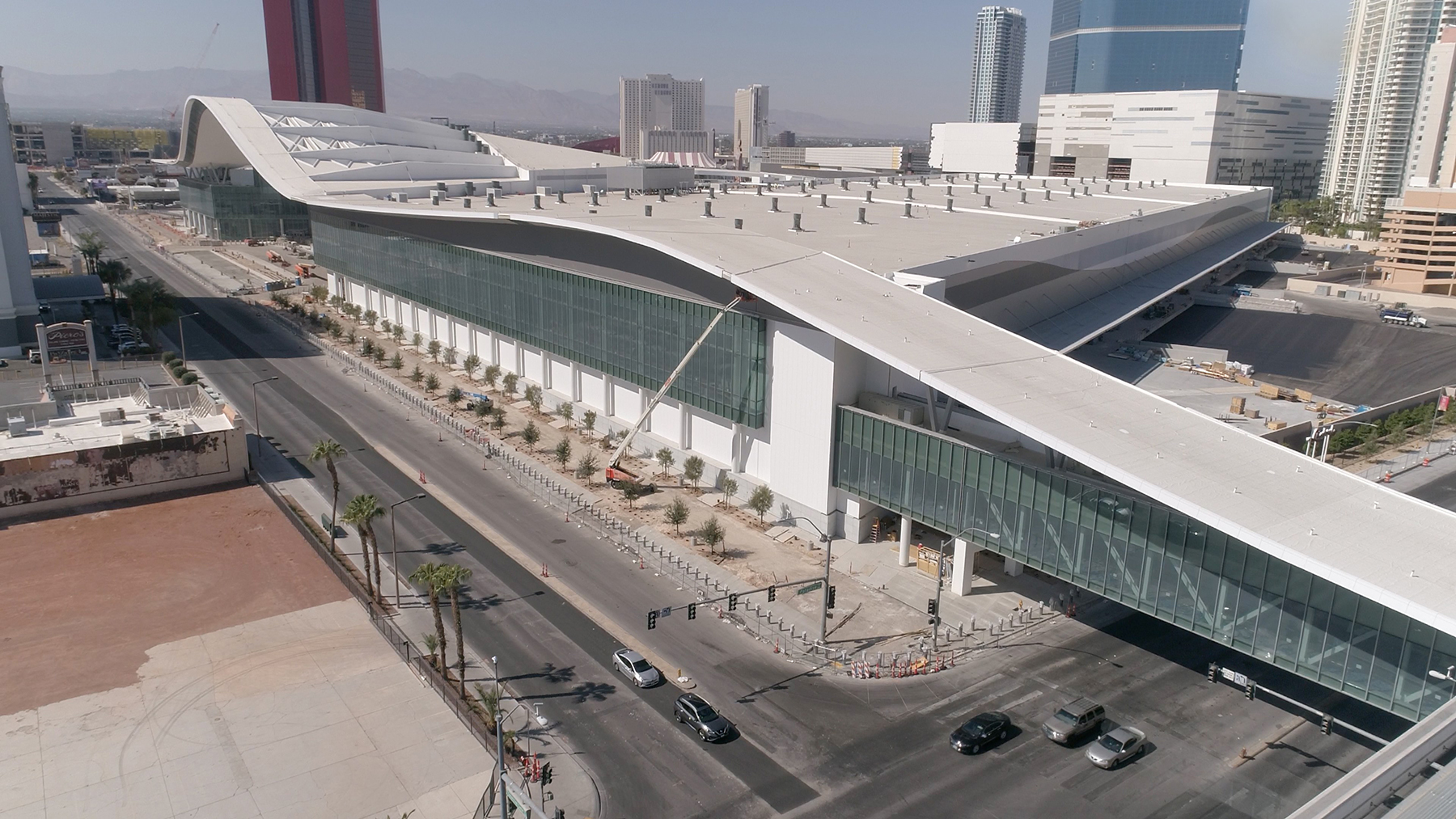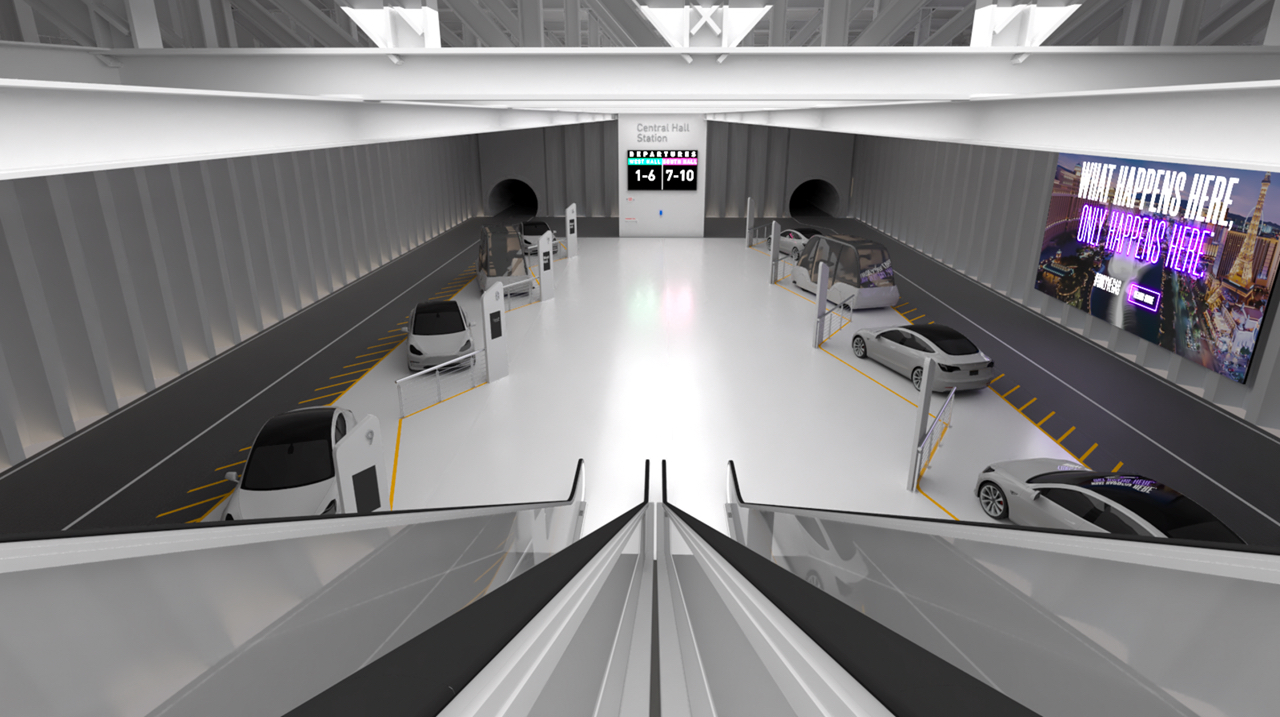When the Las Vegas Convention Center was first built in the late 1950s, it sported a large, distinctive dome, which resembled a flying saucer. But over the ensuing decades the dome was replaced by a campus of functional but generic convention halls. So when the Las Vegas Convention and Visitors Authority — the public agency that runs the convention center and oversees tourism efforts in the valley — first began looking at a significant renovation in the 2000s, crafting a more iconic visual presence for this key driver of the city’s economy was a priority.
That task fell to Atlanta-based design firm TVS Design. “Visitors to Las Vegas expect a degree of showmanship and drama,” says Rob Svedberg, FAIA, a principal with TVS Design.
The centerpiece of the newly imagined convention center is the $980 million, 1.4 million sq ft West Hall.

The West Hall
The West Hall features an undulating, ribbonlike roof that opens up to a giant arched portico at the building’s atrium — a design motif that will eventually be extended across the existing buildings to unify the campus design. Svedberg says the ribbon will function as a central organizing and wayfinding system for the campus: “The ribbon represents the public circulation path,” he says. “It's a cool, dramatic thing, but it also tells visitors ‘This is how you use the building.’”
The West Hall opened at the beginning of the year — a date initially pegged to coincide with the massive CES technology show presented each year by the Consumer Technology Association. Now, with that show going all-online this year, the West Hall will have to wait for business to rebound as more Americans receive the COVID-19 vaccine.
A key element of the design brief was the need for more open exhibit space. In its 600,000 sq ft main exhibit hall, the West Hall features only two rows of columns — each 95 ft from the walls and 252 ft from each other. That middle space between the columns totals 385,000 sq ft of unobstructed floor area. Designers worked through six different schemes trying to balance the size of the column-free spaces — which require deeper trusses — without causing the building’s roof to overwhelm its neighbors.
There’s also a focus on flexibility of movement: The new hall features five flex halls that can be reconfigured into different spaces via walls that can rise up like garage doors. Loading bays are designed to enable trucks to pull in one entrance and out another. Other features include a 59 by 32 ft exterior "elephant door" that's big enough for a yacht to pass into the convention space and a 10,000 sq ft digital screen inside the hall.
But the dynamics of the West Hall itself may not prove to be the most significant feature of the new addition. As with most large convention centers, traversing the significant lengths of the convention center’s current three halls can tax the stamina (and soles) of convention visitors. Adding a fourth building means it will take about a mile to walk from one end of campus to the other.
Moving people
“We recognized we needed to move our customers across the campus,” says Terry Miller, owner of Miller Project Management, the company managing construction of the West Hall. “We looked at a number of methods, from the gondola to a monorail to rubber tires on the road to an underground transportation system.”

The most cost-effective method proved to be a proposal from The Boring Company to drill two narrow tunnels under the convention complex and install a transit system that consists of automated Tesla vehicles capable of holding between three and 12 passengers. (The Boring Company was founded by Elon Musk, the CEO of Tesla.) The 0.86 mi system will feature three stops — the middle stop will be belowground, while both the terminal stops at either end of the line will be aboveground. What would be a 20-minute walk is projected to take just 1 minute, 40 seconds on the system, with vehicles moving through the tunnels at 35 mph.
Convention center officials project the system will be able to move up to 4,400 people per hour in each direction at peak capacity, which would include giant events like CES. The system can also scale down to lower service levels. “It was critically important to us to scale the system to meet varying demand levels,” says Brian Yost, the chief operating officer of the LVCVA. “A fixed rail system or gondola was very difficult to scale up to meet demand or to scale down to meet demand — and thereby scale the cost associated with the system."
The allure of the system is its more affordable construction costs and faster construction timetable because the tunnels are only 13.5 ft in diameter, much smaller than subway tunnels. The smaller size meant less dirt needed to be excavated and complex underground utilities were easier to avoid. The result? Building the two 4,500 ft long tunnels took less than a year, at a cost of only $52.5 million.
Expansion plan
Both the Las Vegas and Clark County (which encompasses the Las Vegas Strip) are moving forward with preliminary plans to extend the subsurface transit system to downtown Las Vegas and along the Las Vegas Strip — a distance of more than 8 mi.
“This is an express system,” said Steve Davis, president of The Boring Company, during a November public meeting with the Las Vegas Planning Commission. “If you built a subway from Fremont Street to the airport and you have 30 stops all along the way, that's a very long ride. (It’s) also very expensive to build that subway. If you have an express system where you go directly from one place to another, then it's a very short ride.”
In his public remarks, Davis promised the technology could reduce a trip from the convention center to downtown (a distance of about 2.7 mi) from 14 minutes to three.
“The advantage this technology offers is (that) it has little interaction with the rest of traffic. So travel times for the same amounts of distance will be lower,” says Shashi Nambisan, Ph.D., P.E., M.ASCE, director of the Transportation Research Center at the University of Nevada, Las Vegas. Further, he adds, because the vehicles will be connected to one another through communications networks, vehicles can safely travel with shorter headways, perhaps as little as one second. This will significantly increase capacity for comparable rights of way used for vehicular travel.
The Boring Company has proposed other transit projects across the country, including a line between Washington, D.C., and Baltimore and a line in Los Angeles, but at the moment Las Vegas is poised to place the biggest bet. “It’s a game changer for transportation,” says Miller. “This is a big deal.




